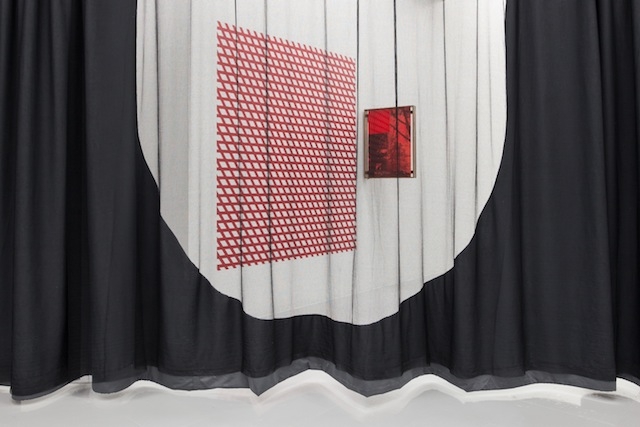In the basement of a residential building in Lisbon’s Xabregas area, a curtain is snaking through the shaftlike space. The curtain is black, with see-through parts shaped like clouds or cave openings. Through the fine fabric mesh, the viewer can spot wooden frames the size of old-fashioned bathroom mirrors hanging perpendicularly from the walls using elegant black metal hinges that can be moved according to the preferences of the viewer. The frames hold layered images of buildings and trees printed on both sides of acrylic glass, together with geometric abstract shapes in bright colours. Like the curtain, the frames are both opaque and transparent; they are boundaries, but not dogmatic ones.
The curtain, titled All Our Tomorrows (all works 2016), functions as a spatial denominator, and the frames are support structures, devices that hold other things up for us to see and experience. Such ‘apparatuses of visibility’, appliances of access, have long been artist Céline Condorelli’s special interest. In 2009 she published the book Support Structures together with Gavin Wade, which is ‘a manual for those things that give, in short, support. While the work of supporting might traditionally appear as subsequent, unessential, and lacking value in itself, this manual is an attempt to restore attention to one of the neglected, yet crucial modes through which we apprehend and shape the world.’
In Condorelli’s exhibition at Kunsthalle Lissabon some of the works determine the space, manipulating the view and movement of visitors in a manner that almost encourages a game of hide-and-seek. Small colourful wooden spinning-tops looking like miniature merry-go-rounds feature in the show, and a copy of a book on artist Palle Nielsen’s utopian playground The Model: a Model for a Qualitative Society at Moderna Museet in Stockholm from 1968 is included in the small study area. Equally significant in this context is the architect Lina Bo Bardi, who famously argued that a museum should contain a playground, something that Condorelli finally realised with a merry-go-round at the Bo Bardi-designed museum MASP in São Paulo earlier this year as part of the group exhibition Playgrounds 2016. In Lisbon that interest continues: Bo Bardi’s outstanding SESC Pompeia (a centre for culture, leisure and education formed out of an old factory in São Paulo inaugurated in 1986), has left its traces in the show, most obviously in the see-through parts of that curtain, shaped like the windows of the building.
The drive to be together under circumstances other than the ones we are used to has been strong in art over the last decades, both as a topic and as a methodology, for example how to live, study and work together. And this drive has not diminished; on the contrary, as we view structures – supportive or not – falling apart on all levels under late capitalism, it seems more urgent than ever before. Condorelli is one of the most interesting voices in this regard, with a second book pertaining to the topic – The Company She Keeps – published in 2014. In it, the artist takes a close look at the practice and philosophy of friendship, as a particular kind of support structure with which surprisingly few female philosophers have engaged with. A rare and distinct support structure, although its stability is also in danger due to people’s general lack of time.
Surrounded by Condorelli’s works in Lisbon, I am reminded of Félix Guattari’s 1988 essay ‘The Three Ecologies’, in which the late French philosopher maintains that the effects of IWC – Integrated World Capitalism – necessitate a new ‘ecosophy’, one that puts forth three types of ecology: that of human subjectivity, that of social relations and that of the environment. Each ecology needs its own radical reformulation in the age of IWC, but, more than anything, it is necessary to rethink how they coexist and intermingle. In this remarkably fresh and politically pressing text he calls for new paradigms that are ‘ethico-aesthetic in inspiration’. It seems to me that Condorelli’s exhibition at Kunsthalle Lissabon and its acute sensibility towards self-determined collective ways of being together, and her practice overall with the recent work on friendship and its values and vicissitudes for that matter, do some of that.
This article first appeared in the December issue of ArtReview
